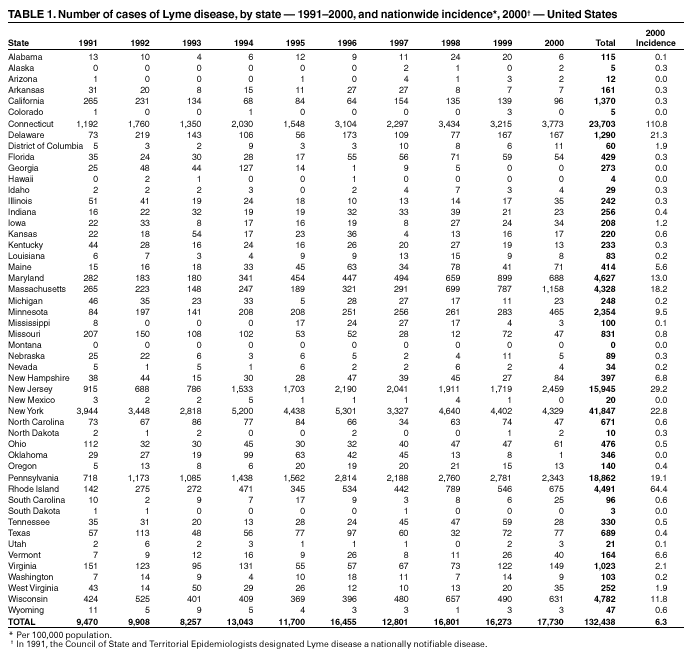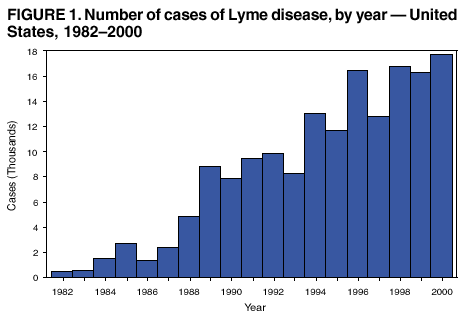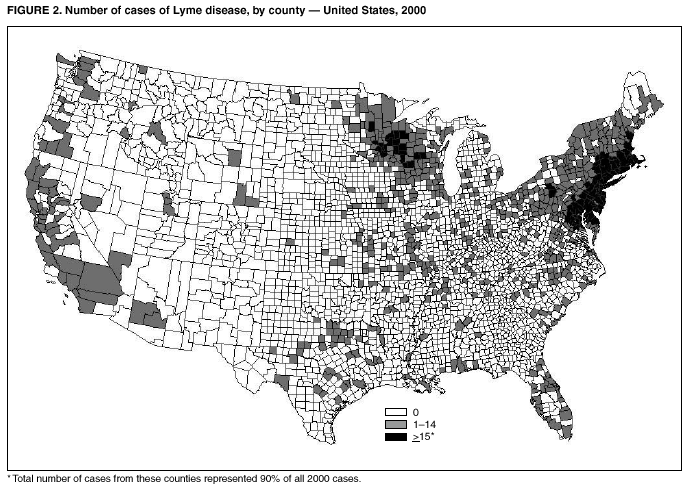 |
|
|
|
|
|
|
|
|
|
|
|
|
|
|
|
|
||||
| ||||||||||
|
|
|
|
Lyme Disease --- United States, 2000Lyme disease (LD) is caused by the tickborne spirochete Borrelia burgdorferi sensu lato and is the most common vectorborne disease in the United States. CDC initiated LD surveillance in 1982, and the Council of State and Territorial Epidemiologists designated it a nationally notifiable disease in 1991. This report summarizes the 17,730 cases of LD reported to CDC during 2000, which indicates that more LD cases were reported in 2000 than in any previous reporting year and that the reported incidence of LD is greatest in the northeastern, mid-Atlantic, and north-central regions of the United States. LD can be prevented by reducing tick populations, avoiding tick-infested habitats, using repellents, promptly removing attached ticks, and vaccination. For surveillance purposes, LD is defined as the presence of a physician-diagnosed erythema migrans (EM) rash >5 cm in diameter or at least one manifestation of musculoskeletal, neurologic, or cardiovascular disease with laboratory confirmation of B. burgdorferi infection (1). Incidence was calculated using 2000 population data from the U.S. Census Bureau. During 2000, a total of 17,730 LD cases (incidence*: 6.3 cases) were reported from 44 states and the District of Columbia, an 8% increase over 1999 (16,273 cases) and a 5% increase over 1998 (16,801 cases) (Figure 1). As in previous years, most cases were reported from the northeastern, mid-Atlantic, and north-central regions (Table 1). State incidence was higher than the national incidence in Connecticut (110.8), Rhode Island (64.4), New Jersey (29.2), New York (22.8), Delaware (21.3), Pennsylvania (19.1), Massachusetts (18.2), Maryland (13.0), Wisconsin (11.8), Minnesota (9.5), New Hampshire (6.8), and Vermont (6.6); these 12 states accounted for 16,877 (95%) of nationally reported cases. During 1999--2000, 24 states and the District of Columbia reported increases in the number of cases, 19 reported decreases, and seven reported no change. In 2000, no cases were reported in six states (Colorado, Georgia, Hawaii, Montana, New Mexico, and South Dakota). Based on data for 17,570 (99%) LD cases, 723 (23%) of 3,143 U.S. counties reported at least one case; approximately 90% of the cases were reported from 124 counties (Figure 2). Reported incidence was >100 cases in 24 counties in Connecticut, Maryland, Massachusetts, New Jersey, New York, Pennsylvania, Rhode Island, and Wisconsin; the highest incidence (943) was reported in Columbia County, New York. Among 17,551 LD patients with age reported, distribution was bimodal and the median age was 39 years (range: <1--98 years). The highest reported incidence occurred among children aged 5--9 years (9.3) and adults aged 50--59 years (8.2). Among 17,663 patients with sex reported, 9,472 (53.6%) were males, who had a higher incidence compared with females in all age groups. Among 12,977 (73.2%) patients with month of illness onset reported, 7,427 (57.2%) occurred during June (27.3%) and July (29.9%); <5.8% occurred during January, February, and December 2000. Reported by: State and District of Columbia health depts. S Marshall, MPH, E Hayes, MD, D Dennis, MD, Div of Vector-borne Infectious Diseases, National Center for Infectious Diseases, CDC. Editorial Note:During 1991--2000, the reported incidence of LD nearly doubled. Most cases continued to occur in northeastern, mid-Atlantic, and north-central states (2,3), and the largest proportion of cases continued to be reported among persons aged 5--9 years and 50--59 years, possibly as a result of greater exposure than other groups to infected ticks, less frequent use of personal protective measures, differential use of health-care services, and/or reporting bias. The large number of reported LD cases during June and July reflects the seasonal peak of host-seeking activities of infective nymphal-stage vector ticks during May and June in areas where LD is endemic (4). The findings in this report are subject to at least three limitations. First, because LD is reported through passive surveillance, LD is underreported, and the distribution and demographics of reported cases could be biased. Second, LD is underreported in areas where disease is endemic and might be overreported in areas where disease is nonendemic. Third, not all LD patients present with typical manifestations; other conditions might be confused with LD and laboratory testing might be inaccurate. LD can be prevented by reducing tick populations, avoiding tick-infested areas, using repellents, promptly removing attached ticks, and vaccination. Booster doses may be required, but the optimal schedule for this has not been determined. A vaccine was licensed in 1998 that is 76% effective in preventing LD among recipients of 3 doses (5). New strategies for reducing tick vectors of LD include applying acaricides to the principal animal hosts of Ixodes scapularis ticks (i.e., a device for killing ticks on white-tailed deer and a bait box for killing ticks on rodents) (6, CDC, unpublished data, 2001). In 2001, community-based LD prevention projects were initiated in Connecticut, Massachusetts, New Jersey, and New York. Through the application of integrated prevention strategies in community-based programs, CDC and state health departments hope to achieve the 2010 national health objective of reducing the incidence of LD to 9.7 in states where LD is endemic (objective 14-8). References
*Per 100,000 population. Table 1  Return to top. Figure 1  Return to top. Figure 2  Return to top.
Disclaimer All MMWR HTML versions of articles are electronic conversions from ASCII text into HTML. This conversion may have resulted in character translation or format errors in the HTML version. Users should not rely on this HTML document, but are referred to the electronic PDF version and/or the original MMWR paper copy for the official text, figures, and tables. An original paper copy of this issue can be obtained from the Superintendent of Documents, U.S. Government Printing Office (GPO), Washington, DC 20402-9371; telephone: (202) 512-1800. Contact GPO for current prices. **Questions or messages regarding errors in formatting should be addressed to mmwrq@cdc.gov.Page converted: 1/17/2002 |
|||||||||
This page last reviewed 1/17/2002
|